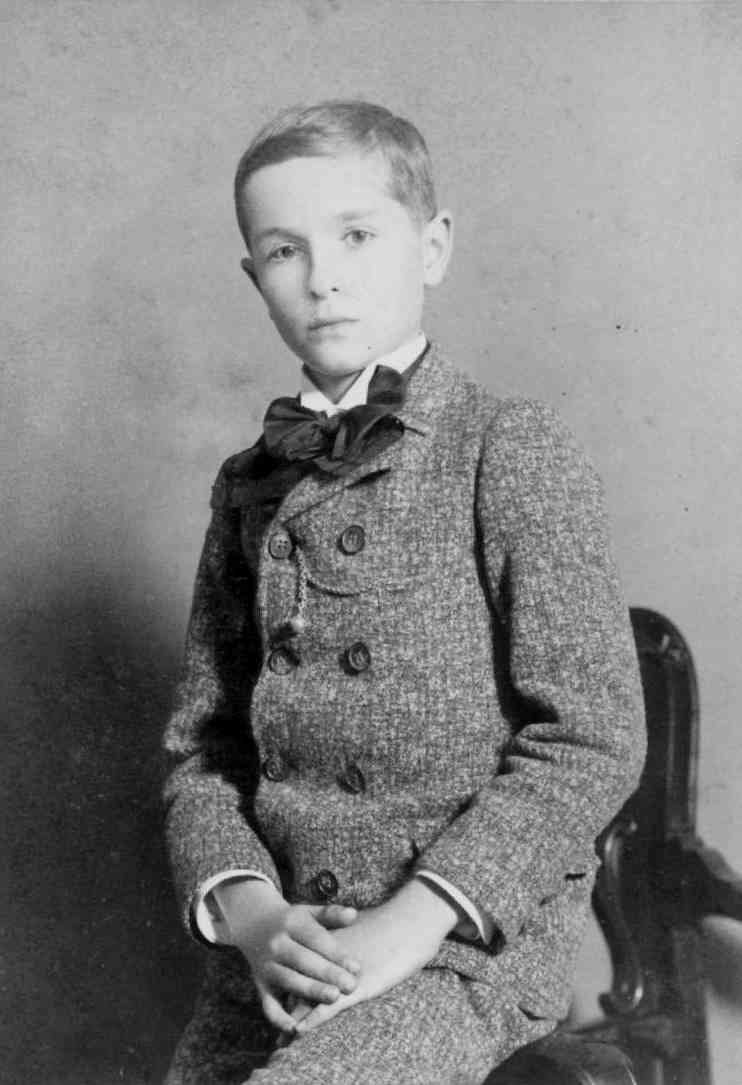
United States Boys' Clothes: Suit Material

Figure 1.--This cabinent card portrait is unidentified. All we know for sure is that the photographer was A. Parker Rolfe of Arch Street Street in Philadelphia, Pennsylvania. The boy is rather elegantly dressed. We suspect he came from a family of comfortable means. He is carefully posed with his hands clasped. He looks to be wearing a wing collar with a small floppy bow. I think the suit material would be called tweed. Notice the watch fob which seems too have a pearl on the end. A child sized pocket watch is presumably in that pocket.
|
|
We do not yet have much information on the different fabrics used for suits. Here as our site is primarily constructed through old photographs, it is very difficult to assess fabrics. There were fabrics of different weights for both summer and winter. As suits were much more commonly worn in the 19th and early 20th century than in the mid- and late-20th century. Thus suits of different weights were more important. Of course, lower-income families could not afford more than one good suit. Some heavier fabrics included cheviot, corduroy, duck, flannel, serge, tweed, and many others. Flannel was a very widely worn fabric in the 20th century. Velvet was also a heavy fabric, but mostly used for fancy suits like Fauntleroy suits for younger boys. We note some sailor suits also done in velvet. We are less sure about the lighter-weight fabrics. One would be searsucker, but that was a 20th century fabric. We know some lighter-weignt suits were done in linnen. It is difficult and often impossible to assess most fabrics from photoraphs. There is, however, information on fabrics in the catalog section, especially the U.S. section which is the most developed that provides some information..
We note boys wearing corduroy suits in the late-19th century. Corduroy is a little easier to identify in old photograsphs than many other fabrics. Corduroy suits might have been worn earlier, but we have not yet found exampls from mid-century. Well made corduroy is very durable garment. We believe it was prinary seen as a fabric for working-class Americans. That certainly was the case in Europe. We suspectthe same was true for America, although we do not have much documentation. This changed in the 20th century. Corduroy knickers were a standard school garment. I think many were part of corduroy suits. Corduroy was popular for school because it was so hard wearing. We are not entirely syure about the colors. We know brown was popular. We are less sure about other colors. Germany imported corduroy from England and called in Manchester Cloth. We are not sure to what extent corduroy sas produced domestically in the United Stastes.
Flannel
Flannel was a popular material for suits in both the 19th and 20th centuries. We note both flannel suits and blazers. A flannel blue blazer sas a sandard for American boys in the 20h centtury.
Linnen
Tweed
Twwed was a very popular fabric for both boys and men's suits. Clothing catalogs commonly offer suits done in a wide varierty of tweeds. We believe the boy here is wearing a tweed suit (figure 1). Most aterial is difficult to identify in the photographic record, but close-ups can sometines give a good idea about the gabric and weave.
Velvet
BTrue vekvet is an expensive fabric as it conrains at least some silk. We see it being used fir dressy children's wear, both girls' dresses and biys' suits. The boys' outfit most associated with velvet is the classic Little Lord Fauntleroy suit. We also see sailor suits done in velvet. This was not very common, but because so many boys' wore sailor suits, there are quite a few examples in the photographic record.
HBC

Navigate the Boys' Historical Clothing Web Site:
[Return to the Main U.S. suit page]
[Return to the Main U.S. country garment page]
[Introduction]
[Activities]
[Biographies]
[Chronology]
[Clothing styles]
[Countries]
[Bibliographies]
[Contributions]
[FAQs]
[Glossary]
[Images]
[Links]
[Registration]
[Tools]
[Boys' Clothing Home]
Created: 9:52 PM 7/21/2008
Last updated: 6:19 AM 1/11/2015



